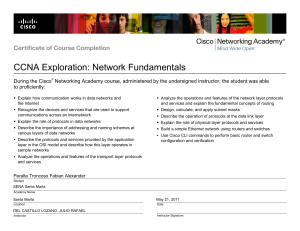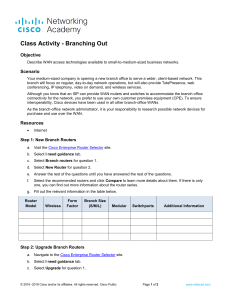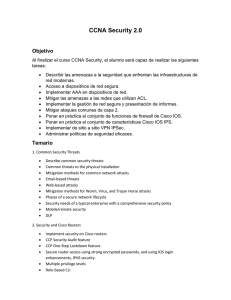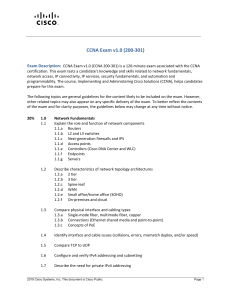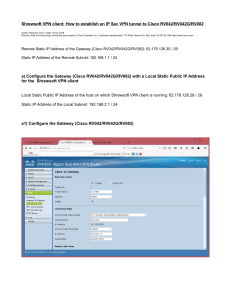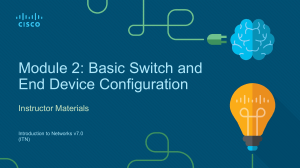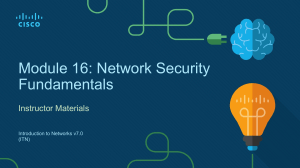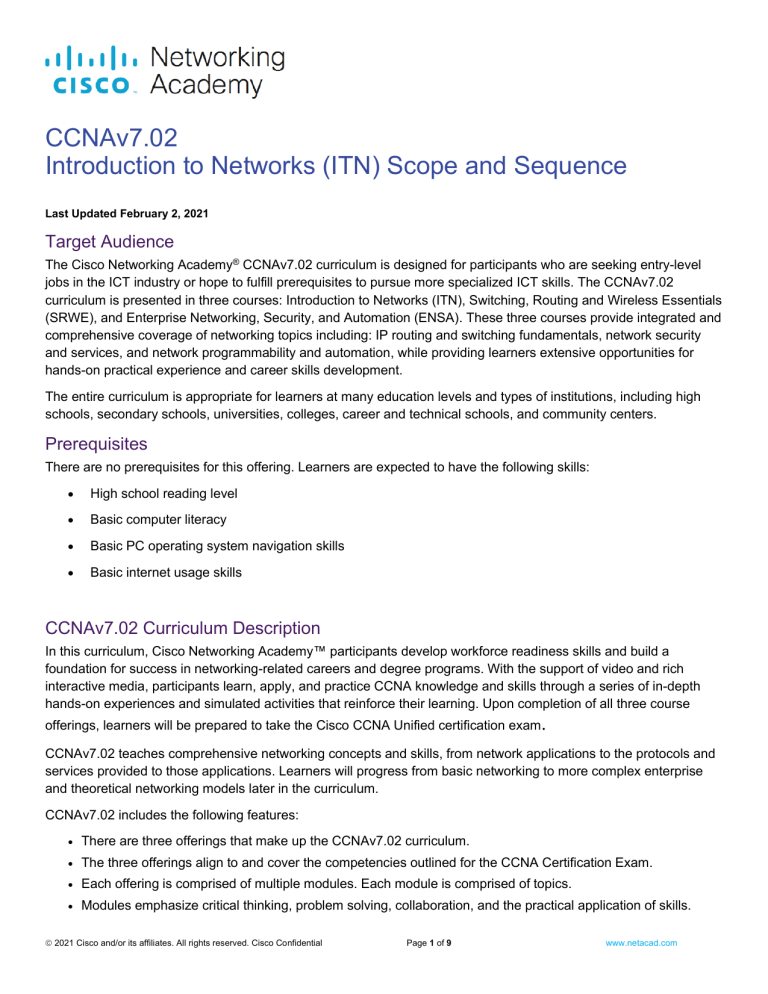
CCNAv7.02 Introduction to Networks (ITN) Scope and Sequence Last Updated February 2, 2021 Target Audience The Cisco Networking Academy® CCNAv7.02 curriculum is designed for participants who are seeking entry-level jobs in the ICT industry or hope to fulfill prerequisites to pursue more specialized ICT skills. The CCNAv7.02 curriculum is presented in three courses: Introduction to Networks (ITN), Switching, Routing and Wireless Essentials (SRWE), and Enterprise Networking, Security, and Automation (ENSA). These three courses provide integrated and comprehensive coverage of networking topics including: IP routing and switching fundamentals, network security and services, and network programmability and automation, while providing learners extensive opportunities for hands-on practical experience and career skills development. The entire curriculum is appropriate for learners at many education levels and types of institutions, including high schools, secondary schools, universities, colleges, career and technical schools, and community centers. Prerequisites There are no prerequisites for this offering. Learners are expected to have the following skills: • High school reading level • Basic computer literacy • Basic PC operating system navigation skills • Basic internet usage skills CCNAv7.02 Curriculum Description In this curriculum, Cisco Networking Academy™ participants develop workforce readiness skills and build a foundation for success in networking-related careers and degree programs. With the support of video and rich interactive media, participants learn, apply, and practice CCNA knowledge and skills through a series of in-depth hands-on experiences and simulated activities that reinforce their learning. Upon completion of all three course offerings, learners will be prepared to take the Cisco CCNA Unified certification exam. CCNAv7.02 teaches comprehensive networking concepts and skills, from network applications to the protocols and services provided to those applications. Learners will progress from basic networking to more complex enterprise and theoretical networking models later in the curriculum. CCNAv7.02 includes the following features: ● There are three offerings that make up the CCNAv7.02 curriculum. ● The three offerings align to and cover the competencies outlined for the CCNA Certification Exam. ● Each offering is comprised of multiple modules. Each module is comprised of topics. ● Modules emphasize critical thinking, problem solving, collaboration, and the practical application of skills. © 2021 Cisco and/or its affiliates. All rights reserved. Cisco Confidential Page 1 of 9 www.netacad.com CCNAv7.02 Introduction to Networks (ITN) Scope and Sequence ● Each topic contains a Check Your Understanding interactive quiz, or some other way to assess understanding, such as a lab or a Packet Tracer. These topic-level assessments are designed to tell learners if they have a good grasp of the topic content, or if they need to review before continuing. Learners can ensure their level of understanding well before taking a graded quiz or exam. Check Your Understanding quizzes do not affect the learner’s overall grade. ● Students learn the basics of routing, switching, and advanced technologies to prepare for the Cisco CCNA exam, networking-related degree programs, and entry-level networking careers. ● The language used to describe networking concepts is designed to be easily understood by learners at all levels and embedded interactive activities help reinforce comprehension. ● Assessments and practice activities are focused on specific competencies to increase retention and provide flexibility in the learning path. ● Multimedia learning tools, including videos, games, and quizzes, address a variety of learning styles and help stimulate learning and promote increased knowledge retention. ● Hands-on labs and Cisco® Packet Tracer simulation-based learning activities help students develop critical thinking and complex problem-solving skills. When access to equipment is limited or not possible, a corresponding Packet Tracer Physical Mode (PTPM) activity is provided to emulate the physical, in-person lab experience. ● PTPM scenarios provide additional opportunities to explore the end-to-end physical connections of simple and globally distributed networks. ● Embedded assessments provide immediate feedback to support the evaluation of knowledge and acquired skills. ● Cisco Packet Tracer activities are designed for use with the latest version of Packet Tracer. Lab Equipment Requirements Networking Academy CCNA courses can be delivered in person or remotely. Hands-on experiences with physical equipment continue to remain an essential best practice, and Networking Academy has no plan to remove this requirement. Academies need to continue providing access to physical equipment as soon as circumstances allow it. However, to support distance learning, lab activities now provide the option to practice skills with PTPM or with lab equipment, if available. Packet Tracer 8.0 provides support for students to practice critical skills normally presented in the physical, in-person lab experience. Networking Academy offers this option as a way to offset the skills gap created by the absence of physical equipment and continue on the path toward student mastery. Packet Tracer 8.0, 64-bit versions are required for the optimal experience with CCNA 7.PTPM activities and scenarios. Due to the extensive set of graphics included in the PTPM scenarios, these activities may experience performance issues or crashes in Packet Tracer 8.0, 32-bit version. All other PTPM activities should perform as normal. Current designs for lab topologies leverage equipment used in CCNAv6 and include options to utilize a 2 router + 2 switch + 1 wireless router physical equipment bundle described below. Labs with more complex topologies will rely on PT as a complementary environment to be used in addition to the physical labs. Detailed equipment information, including descriptions and part numbers for the equipment used in CCNAv6 is available in the CCNA Equipment List, which is located on the Cisco NetAcad Equipment Information site (https://www.netacad.com/portal/resources/equipment-information). © 2021 Cisco and/or its affiliates. All rights reserved. Cisco Confidential Page 2 of 9 www.netacad.com CCNAv7.02 Introduction to Networks (ITN) Scope and Sequence Baseline Equipment Bundle: • 2 x ISR4221/K9 Routers • 2 x WS-C2960+24TC-L Catalyst switches • 1 wireless router (generic brand) with WPA2 support • Ethernet patch cables • PCs - minimum system requirements o CPU: Intel Pentium 4, 2.53 GHz or equivalent o OS: Microsoft Windows 7, Microsoft Windows 8.1, Microsoft Windows 10, Ubuntu 14.04 LTS, macOS High Sierra and Mojave o RAM: 4 GB o Storage: 500 MB of free disk space o Display resolution: 1024 x 768 o Language fonts supporting Unicode encoding (if viewing in languages other than English) o Latest video card drivers and operating system updates Internet connection for lab and study PCs • • Optional equipment for connecting to a WLAN o 1 printer or integrated printer/scanner/copier for the class to share o Smartphones and tablets are desirable for use with the labs Software: • Cisco IOS versions: o Routers: Version 15.0 or higher, IP Base feature set o Switches: Version 15.0 or higher, lanbaseK9 feature set • Packet Tracer 8.0 • Open-source server software: o For various services and protocols, such as Telnet, SSH, HTTP, DHCP, FTP, TFTP, etc. • • • Tera Term source SSH client software for lab PCs. Oracle VirtualBox, most recent version. Wireshark version 2.5 or higher. CCNAv7.02: Introduction to Networks (ITN) Outline The first course in the CCNA curriculum introduces the architectures, models, protocols, and networking elements that connect users, devices, applications and data through the internet and across modern computer networks including IP addressing and Ethernet fundamentals. By the end of the course, students can build simple local area networks (LANs) that integrate IP addressing schemes, foundational network security, and perform basic configurations for routers and switches. Listed below are the current set of modules and their associated competencies outlined for this course. Each module is an integrated unit of learning that consists of content, activities and assessments that target a specific set © 2021 Cisco and/or its affiliates. All rights reserved. Cisco Confidential Page 3 of 9 www.netacad.com CCNAv7.02 Introduction to Networks (ITN) Scope and Sequence of competencies. The size of the module will depend on the depth of knowledge and skill needed to master the competency. Some modules are considered foundational, in that the artifacts presented, while not assessed, enable learning of concepts that are covered on the CCNA certification exam. CCNAv7.02: ITN Module Topic Networking Today Module Objective Explain the advances in modern network technologies. Networks Affect Our Lives Explain how networks affect our daily lives. Network Components Explain how host and network devices are used. Network Representations and Topologies Explain network representations and how they are used in network topologies. Common Types of Networks Compare the characteristics of common types of networks. Internet Connections Explain how LANs and WANs interconnect to the internet. Reliable Networks Describe the four basic requirements of a reliable network. Network Trends Explain how trends such as BYOD, online collaboration, video, and cloud computing are changing the way we interact. Network Security Identify some basic security threats and solutions for all networks. The IT Professional Explain employment opportunities in the networking field. Topic Objective Basic Switch and End Device Configuration Implement initial settings including passwords, IP addressing, and default gateway parameters on a network switch and end devices. Cisco IOS Access Explain how to access a Cisco IOS device for configuration purposes. IOS Navigation Explain how to navigate Cisco IOS to configure network devices. The Command Structure Describe the command structure of Cisco IOS software. Basic Device Configuration Configure a Cisco IOS device using CLI. Save Configurations Use IOS commands to save the running configuration. Ports and Addresses Explain how devices communicate across network media. © 2021 Cisco and/or its affiliates. All rights reserved. Cisco Confidential Page 4 of 9 www.netacad.com CCNAv7.02 Introduction to Networks (ITN) Scope and Sequence Module Configure IP Addressing Configure a host device with an IP address. Verify Connectivity Verify connectivity between two end devices. Topic Objective Protocols and Models Module Explain how network protocols enable devices to access local and remote network resources. The Rules Describe the types of rules that are necessary to successfully communicate. Protocols Explain why protocols are necessary in network communication. Protocol Suites Explain the purpose of adhering to a protocol suite. Standards Organizations Explain the role of standards organizations in establishing protocols for network interoperability. Reference Models Explain how the TCP/IP model and the OSI model are used to facilitate standardization in the communication process. Data Encapsulation Explain how data encapsulation allows data to be transported across the network. Data Access Explain how local hosts access local resources on a network. Topic Objective Explain how physical layer protocols, services, and network media support communications across data networks. Physical Layer Module Purpose of the Physical Layer Describe the purpose and functions of the physical layer in the network. Physical Layer Characteristics Describe characteristics of the physical layer. Copper Cabling Identify the basic characteristics of copper cabling. UTP Cabling Explain how UTP cable is used in Ethernet networks. Fiber-Optic Cabling Describe fiber-optic cabling and its main advantages over other media. Wireless Media Connect devices using wired and wireless media. Topic Objective Calculate numbers between decimal, binary, and hexadecimal systems. Number Systems Binary Number System © 2021 Cisco and/or its affiliates. All rights reserved. Cisco Confidential Calculate numbers between decimal and binary systems. Page 5 of 9 www.netacad.com CCNAv7.02 Introduction to Networks (ITN) Scope and Sequence Module Hexadecimal Number System Calculate numbers between decimal and hexadecimal systems. Topic Objective Explain how media access control in the data link layer supports communication across networks. Data Link Layer Module Purpose of the Data Link Layer Describe the purpose and function of the data link layer in preparing communication for transmission on specific media. Topologies Compare the characteristics of media access control methods on WAN and LAN topologies. Data Link Frame Describe the characteristics and functions of the data link frame. Topic Objective Ethernet Switching Module Explain how Ethernet operates in a switched network. Ethernet Frame Explain how the Ethernet sublayers are related to the frame fields. Ethernet MAC Address Describe the Ethernet MAC address. The MAC Address Table Explain how a switch builds its MAC address table and forwards frames. Switch Speeds and Forwarding Methods Describe switch forwarding methods and port settings available on Layer 2 switch ports. Topic Objective Explain how routers use network layer protocols and services to enable end-to-end connectivity. Network Layer Module Network Layer Characteristics Explain how the network layer uses IP protocols for reliable communications. IPv4 Packet Explain the role of the major header fields in the IPv4 packet. IPv6 Packet Explain the role of the major header fields in the IPv6 packet. How a Host Routes Explain how network devices use routing tables to direct packets to a destination network. Router Routing Tables Explain the function of fields in the routing table of a router. Topic Objective © 2021 Cisco and/or its affiliates. All rights reserved. Cisco Confidential Page 6 of 9 www.netacad.com CCNAv7.02 Introduction to Networks (ITN) Scope and Sequence Explain how ARP and ND enable communication on a network. Address Resolution Module MAC and IP Compare the roles of the MAC address and the IP address. ARP Describe the purpose of ARP. Neighbor Discovery Describe the operation of IPv6 neighbor discovery. Topic Objective Basic Router Configuration Module Implement initial settings on a router and end devices. Configure Initial Router Settings Configure initial settings on a Cisco IOS router. Configure Interfaces Configure two active interfaces on a Cisco IOS router. Configure the Default Gateway Configure devices to use the default gateway. Topic Objective Calculate an IPv4 subnetting scheme to efficiently segment a network. IPv4 Addressing Module IPv4 Address Structure Describe the structure of an IPv4 address including the network portion, the host portion, and the subnet mask. IPv4 Unicast, Broadcast, and Multicast Compare the characteristics and uses of the unicast, broadcast and multicast IPv4 addresses. Types of IPv4 Addresses Explain public, private, and reserved IPv4 addresses. Network Segmentation Explain how subnetting segments a network to enable better communication. Subnet an IPv4 Network Calculate IPv4 subnets for a /24 prefix. Subnet a /16 and /8 Prefix Calculate IPv4 subnets for a /16 and /8 prefix. Subnet to Meet Requirements Given a set of requirements for subnetting, implement an IPv4 addressing scheme. Variable Length Subnet Masking Explain how to create a flexible addressing scheme using variable length subnet masking (VLSM). Structured Design Implement a VLSM addressing scheme. Topic Objective IPv6 Addressing Implement an IPv6 addressing scheme. IPv4 Issues Explain the need for IPv6 addressing. IPv6 Addressing Explain how IPv6 addresses are represented. © 2021 Cisco and/or its affiliates. All rights reserved. Cisco Confidential Page 7 of 9 www.netacad.com CCNAv7.02 Introduction to Networks (ITN) Scope and Sequence Module IPv6 Address Types Compare types of IPv6 network addresses. GUA and LLA Static Configuration Explain how to configure static global unicast and linklocal IPv6 network addresses. Dynamic Addressing for IPv6 GUAs Explain how to configure global unicast addresses dynamically. Dynamic Addressing for IPv6 LLAs Configure link-local addresses dynamically. IPv6 Multicast Addresses Identify IPv6 addresses. Subnet an IPv6 Network Implement a subnetted IPv6 addressing scheme. Topic Objective ICMP Module Use various tools to test network connectivity. ICMP Messages Explain how ICMP is used to test network connectivity. Ping and Traceroute Testing Use ping and traceroute utilities to test network connectivity. Topic Objective Compare the operations of transport layer protocols in supporting end-to-end communication. Transport Layer Module Transportation of Data Explain the purpose of the transport layer in managing the transportation of data in end-to-end communication. TCP Overview Explain characteristics of the TCP. UDP Overview Explain characteristics of the UDP. Port Numbers Explain how TCP and UDP use port numbers. TCP Communication Process Explain how TCP session establishment and termination processes facilitate reliable communication. Reliability and Flow Control Explain how TCP protocol data units are transmitted and acknowledged to guarantee delivery. UDP Communication Describe the UDP client processes to establish communication with a server. Topic Objective Explain the operation of application layer protocols in providing support to end-user applications. Application Layer Application, Presentation, and Session © 2021 Cisco and/or its affiliates. All rights reserved. Cisco Confidential Explain how the functions of the application layer, session layer, and presentation layer work together to provide network services to end user applications. Page 8 of 9 www.netacad.com CCNAv7.02 Introduction to Networks (ITN) Scope and Sequence Module Peer-to-Peer Explain how end user applications operate in a peer-topeer network. Web and Email Protocols Explain how web and email protocols operate. IP Addressing Services Explain how DNS and DHCP operate. File Sharing Services Explain how file transfer protocols operate. Topic Objective Network Security Fundamentals Module Configure switches and routers with device hardening features to enhance security. Security Threats and Vulnerabilities Explain why basic security measures are necessary on network devices. Network Attacks Identify security vulnerabilities. Network Attack Mitigation Identify general mitigation techniques. Device Security Configure network devices with device hardening features to mitigate security threats. Topic Objective Build a Small Network Implement a network design for a small network to include a router, a switch, and end devices. Devices in a Small Network Identify the devices used in a small network. Small Network Applications and Protocols Identify the protocols and applications used in a small network. Scale to Larger Networks Explain how a small network serves as the basis of larger networks. Verify Connectivity Use the output of the ping and tracert commands to verify connectivity and establish relative network performance. Host and IOS Commands Use host and IOS commands to acquire information about the devices in a network. Troubleshooting Methodologies Describe common network troubleshooting methodologies. Troubleshooting Scenarios Troubleshoot issues with devices in the network. © 2021 Cisco and/or its affiliates. All rights reserved. Cisco Confidential Page 9 of 9 www.netacad.com

